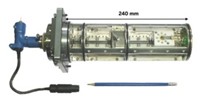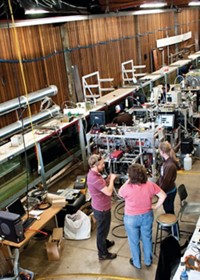Advertisement
Grab your lab coat. Let's get started
Welcome!
Welcome!
Create an account below to get 6 C&EN articles per month, receive newsletters and more - all free.
It seems this is your first time logging in online. Please enter the following information to continue.
As an ACS member you automatically get access to this site. All we need is few more details to create your reading experience.
Not you? Sign in with a different account.
Not you? Sign in with a different account.
ERROR 1
ERROR 1
ERROR 2
ERROR 2
ERROR 2
ERROR 2
ERROR 2
Password and Confirm password must match.
If you have an ACS member number, please enter it here so we can link this account to your membership. (optional)
ERROR 2
ACS values your privacy. By submitting your information, you are gaining access to C&EN and subscribing to our weekly newsletter. We use the information you provide to make your reading experience better, and we will never sell your data to third party members.
Analytical Chemistry
Analyzing Air Nanoparticulates
Mass spec technique characterizes airborne particles smaller than 10 nm
by Celia Henry Arnaud
February 27, 2006
| A version of this story appeared in
Volume 84, Issue 9

The chemical composition of airborne nanoparticles is largely unknown because of measurement difficulties. Chemists at the University of Delaware, Newark, have now developed a nanoaerosol mass spectrometer that combines an aerodynamic inlet, an ion trap, and a time-of-flight mass analyzer to characterize individual particles smaller than 10 nm (Anal. Chem. 2006, 78, 1750).
Instead of taking their chances that they will be able to analyze particles on the fly, the researchers first trap the nanoparticles. There is "very little mass in that size range, and we have to do the analysis at just the right time," says team leader Murray V. Johnston, a chemistry professor. "We put the particle in the right place and then when we're ready to do the analysis, we fire the laser."
The high-energy laser pulse causes the particles to disintegrate completely into atomic ions that are analyzed by time-of-flight mass spectrometry. The relative intensities of the ions reveal the elemental composition of the particles. To demonstrate how the instrument works, the researchers analyzed nanoparticles of sucrose and bovine serum albumin.
Johnston and his coworkers, postdoc Shenyi Wang and grad student Christopher A. Zordan, are particularly interested in using the instrument to monitor environmental and workplace exposure to airborne nanoparticles.
"We breathe in millions of particles a day," Johnston observes. "What is their composition? How does composition change with size?" The information that scientists have for such small particles is "really sketchy," he says. He has already worked with particles larger than 50 nm, so he knows that a wide variety of chemical compositions is possible.
Constantinos Sioutas, a professor of environmental engineering who studies air pollution and aerosol technology at the University of Southern California, notes that particles smaller than 10 nm tend to have short lifetimes in the atmosphere because they either grow or get scavenged by larger particles. Nevertheless, he calls the instrument an "exciting new technology" in particle measurement, "with potentially great significance" for atmospheric science once it is fully developed to overcome some of its limitations, including low ionization and detection efficiencies.
"The instrument we've put together is on wheels," Johnston says. "We can wheel it out of the laboratory to a measurement site, whether that's some workplace location or an air-quality monitoring site."
Johnston is already using the instrument in the lab to study the formation of particles during the oxidation of volatile organic molecules, such as α-pinene (Environ. Sci. Technol. 2006, 40, 1843). "This summer, we plan to take it into the field to do some initial measurements of ambient-particle compositions," he says. Within the next year, his team hopes to look at suspended particles in the air of labs that work with manufactured nanoparticles.






Join the conversation
Contact the reporter
Submit a Letter to the Editor for publication
Engage with us on Twitter